Sejal Agarwal attended the webinar on ‘Growing Her Future: How digital farming can reduce gender divides in agriculture’, organized by the Grameen Foundation and she shares her learnings from the virtual event in this Meeting Note.
CONTEXT
Currently, different technologies are being developed at a rapid pace to digitalize agriculture (Box 1) and agricultural extension and advisory services (EAS). There are a variety of technologies, such as videos, audio messages, Short Messaging Service (SMS), phone calls, live video calls, community radio and social media applications that are being used by various public and private sector actors to digitize the agriculture sector. These technologies are playing a crucial role in helping farmers access real time information on the crops they should grow, the cropping pattern they should adapt, irrigation needs of crops, the likelihood of a pest attack, name, quantity and frequency of pesticides to be used, market rates of crops, online trading of crops, etc., which can help farmers reduce their input costs/loss and thus improve their incomes in the long run. These services equip them with knowledge on how to reduce excessive use of pesticides, make judicious use of natural resources, and thus become ecologically friendly in their farming practices. However, the access and use of these services is not the same for every farmer. While this differential access can stem from variations in literacy, financial capacity, or willingness, all the same one of the major elements that is often ignored is the gender of the producer/farmer.
|
Box 1: ‘Agricultural digitalization’ refers to the process of integrating advanced digital technologies, such as Artificial Intelligence, big data, robotics, unmanned aviation systems, sensors, and communication networks, all connected through the Internet of Things into the farm production system. Source: Lioutas Evagelos D, Charatsari Chrysanthi, and De Rosa Marcello. 2021. Digitalization of agriculture: A way to solve the food problem or a trolley dilemma? Technology in Society 67. |
As per the information collected in Agriculture Census 2015-16, about 11.72 per cent of the total operated area in India was run by female operational holders. However, a report by Oxfam mentioned that in India, 75 per cent of full-time farm workers are women and they contribute 60 to 80 per cent of the country’s annual yield. In any cropping season, women are estimated to invest 3,300 hours in sowing and harvesting, as compared to 1,860 hours that are invested by men in the farming activity. But when it comes to developing a technology and training the farmers on it, women are generally missing from such trainings. The cultural issues and gender norms of society act as impediments for these women farmers from becoming a part of this growing digitization due to their inability to participate as equally as men in the process of technology development, accessibility, and use.
ABOUT THE WEBINAR
This webinar highlighted the importance of engaging women farmers in digitalizing the agricultural extension services. The Grameen Foundation (GF) – with its mission ‘To empower the poor, especially women, to create a world without poverty and hunger’ – emphasized how the organization is taking crucial steps to tackle the problem of providing digital support to farmers, especially women farmers and empowering them in the process. Lakshmi Iyer, Innovations in Agriculture Director; Bobby Gray, Research Director; Alfred Yeboah, Director, Africa; and Gigi Gatti, Senior Director, Program Strategy and Learning from the GF shared their learnings and experiences during the webinar on various issues such as who is a farmer, what is a digital agricultural service, barriers in adoption of digital agricultural services, and the ways to overcome these barriers.
APPROACH OF GRAMEEN FOUNDATION
Lakshmi Iyer explained that the Foundation follows a need-based and targeted approach. For the past 25 years, GF has been partnering with local organizations globally and building their capacities. GF has also been engaging with smallholder farmers, especially women farmers, to improve their income and productivity with the help of digital services. Following a need-based approach, the organization engages with key stakeholders to understand the ecosystem they live in, the gaps that exist, and the support that they need for improving their livelihoods, mainly from the perspectives of women farmers. These are then addressed while deploying the service. A continuous feedback mechanism with all the stakeholders helps the foundation to make technologies efficient and effective.
WOMEN, AGRICULTURE AND CLIMATE CHANGE
Intersectionality of a woman already makes her susceptible to the existing cultural and environmental shocks along with the added dimension of climate change. In general, women farmers are more vulnerable to the effects of climate change as compared to men farmers owing to various socio-economic and cultural barriers. Lack of access to information and her personal constraints, such as work load, restricts her time usage. Climate change majorly affects natural resources which are not only crucial for rural households, such as, firewood, water, etc., but are also managed by women and a major source of livelihood for them. However, women are still not considered important stakeholders in decision making for taking climate adaptation related decisions, neither within families nor within communities. Research states that involving women while making such decisions positively affect not just her family but also the larger community.
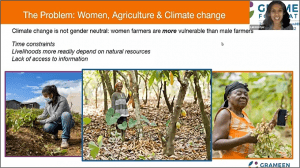 Climate Change and women farmers
Climate Change and women farmers
CHALLENGES FACED BY WOMEN FARMERS IN ADOPTING DIGITAL AGRICULTURE SERVICES
Bobby Gray cited four critical factors while highlighting the challenges – who is a farmer, the time constraints, the permission to take decisions, and the support needed. She initiated the discussion by defining a farmer. Generally, a farmer is defined as someone who owns land. A person who is practicing agriculture for years may not be considered as a farmer unless s/he is the owner of that farm holding. The social status of a woman, such as, separated, divorced or widow, makes it more complicated for these women to assert ownership over the land she might have been cultivating for years. Highlighting the time constraints, a woman farmer is expected to do all the household chores, take care of children, and do the farm work too. However, in the case of men, the work is limited to farm work in almost all the cases. Similarly, due to socio-cultural reasons, many times, women are not allowed to talk to men outside their families, which indicate that they cannot even talk to the extension agent if the latter is a male. With very few female extension agents present in this sector, it makes women farmers more vulnerable. Though financial and technology support is needed, peer support is equally important in their cases.
Generally, women do not have the right to take decisions related to agriculture, so financial support is needed to help her create another source of livelihood that can help the family in diversifying their income source. While imparting technology support, it is important to consider the availability of technology – like smartphones or mobile phones – and the literacy levels of these women. Whenever any training or activity is planned, the existing peer groups should be taken into consideration as that can help in making the training more effective and comfortable for women to attend.
 Programmatic approach of Grameen Foundation
Programmatic approach of Grameen Foundation
DIGITAL AGRICULTURE SERVICES
Alfred Kojo explained the approach of the Grameen Foundation. He spoke of the different ways of providing digital agriculture services, such as radio services, mobile application, voice calls and messages, and capacity building on Information Communication and Technologies (ICTs). These digital services have been providing information on weather, pest management, crop harvest, etc. In Ghana, they had been deploying community radio services for a group of women farmers in their local language. Farmers are also given a recorder that can help them record the session and hear it later at their convenience, thereby addressing the time poverty issue of women farmers.
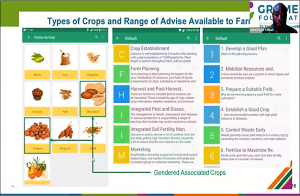 Division of agriculture work and crops as per gender
Division of agriculture work and crops as per gender
Voice messages and calls on a weekly basis have been helping these women farmers to avoid crop loss and improve their income. Short Messaging Service (SMS) is another way that is being deployed depending upon the literacy and comfort level of the farmers, to provide real time agricultural information. Based on the assessment, GF has also analyzed which crops and the related farm work is carried out by which gender and which member of the family. One to one visits of extension agents and the profiles of each farmer captured on the application helps extension agents in understanding the context of each farmer, and customizing the advice suitably. The capacity building and training of these farmers on ICTs is planned and delivered accordingly.
OVERCOMING THE BARRIERS OF DIGITAL AGRICULTURAL SERVICES
Climate change is going to affect everyone in this world and not just women. Not only is it important to include them in the decision-making process, but at the same time, they should not be burdened with being the sole person responsible for tackling it. In order to overcome any barrier, the concept of ‘One size does not fit all’ is critical. The service has to be customized based on social, cultural, economic conditions of the clients and the intersectionality of the receiver. Whenever these factors are considered, it becomes much more convenient and comfortable for a woman to adopt these technologies. When these technologies are deployed among the women, it is important to consider the factor of time poverty. The technology should be easy for them to understand and must not also take up too much of their time to adapt. Be it radio, voice calls, applications, etc., the trainings should be imparted to women at a place and time convenient for them. Apart from time, factors such as cost of technology should also be given due consideration. Extension agents can play an important role by gauging the income level of these farmers before developing the targeting plan and deploying the technologies.
DIGITAL SERVICES OF GRAMEEN FOUNDATION
- Agripath: It provides business and technical management services to farm clients throughout the world. The company was formed with a clear vision to provide financial and physical production data to farmers in a format that allows them to understand their business and assist them to take better business decisions. The Agripath team encompasses experienced consultants who have been providing financial and technical advice to farming and grazing clients for twenty years.[1]This project is supposedly an action research project which is going to compare three kinds of digital services – agent-facilitated, self-service and hybrid model. The comparison of these three services will help the private and public sector to understand how to design these digital agricultural extension services so as to help farmers to the maximum.
- MANDI (Market Access enabled by Digital Innovation in India): It is a one-year initiative being implemented in the Purvanchal region of Uttar Pradesh and aims to strengthen capacity of the farmer producer organizations (FPOs) to connect smallholder farmers, especially women, to markets and finance, and to improve farmers’ incomes and resilience.[2] Use of digital technology and data will connect these FPOs to sources of extension, climate smart practices, markets and finance.
MY LEARNINGS
Women are generally perceived to be the victims of climate change. Properly planned capacity building sessions and digital technology have immense potential to help women farmers understand climate-resilient agricultural practices, such as change in cropping cycles, judicious use of resources, acquiring assets accordingly, etc. Thus, it is important to include them and their perspectives while designing services, tailoring these services to meet their needs and including them as legitimate clients so that they can actively and effectively be engaged in adaptation and mitigation measures within households and communities.
Foot notes
[1]http://www.agripath.com.au/
[2]https://grameenfoundation.in/?page_id=1284
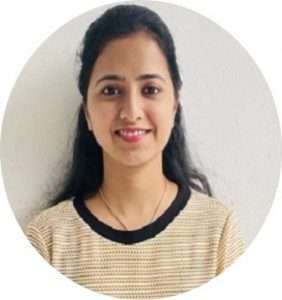 Ms. Sejal Agarwal, Research Fellow at the Centre for Research on Innovation and Science Policy (CRISP), Hyderabad, India (www.crispindia.org). She can be reached at sejal.iifm@gmail.com
Ms. Sejal Agarwal, Research Fellow at the Centre for Research on Innovation and Science Policy (CRISP), Hyderabad, India (www.crispindia.org). She can be reached at sejal.iifm@gmail.com

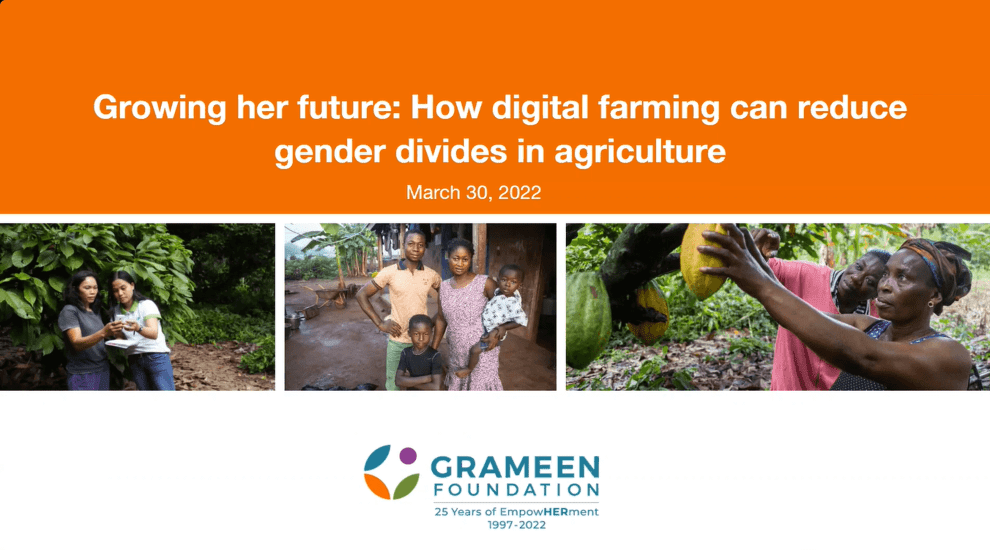

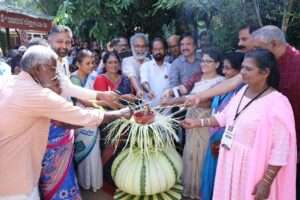

Add Comment